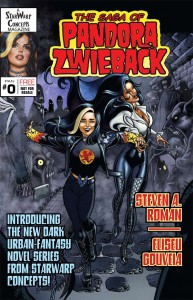
Over at the news site
Comics for Sinners, you’ll find my review of
Lady Demon: Hell to Pay, currently available from Dynamite Entertainment. Written by Aaron Gillespie (
Purgatori: Hell and Back, The Bionic Man), with art by Mirka Andolfo (
Chaos: Highway to Hel, DC Comics Bombshells) and Juanan Ramirez (
Altered States: Red Sonja, Chaos: Smiley the Psychotic Button), it collects the 2015 four-issue miniseries that follows the adventures of the archduchess of Hell as she flees the netherworld for the safety of…Arkansas? It’s an enjoyable nod to 1970s Southern Gothic horror movies that you might want to check out. Head over to C4S to learn more.
Speaking of hell-powered bad girls inspired by 1970s horror movies, have you met Lorelei, StarWarp Concepts’ resident soul-stealing succubus? Making her comics debut in 1993, Lori has remained SWC’s first leading lady of horror, and currently stars in two critically acclaimed projects:
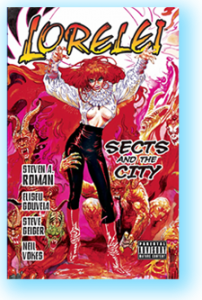 Lorelei: Sects and the City is a Mature Readers graphic novel in which Lori battles a cult of Elder God worshipers attempting to unleash hell on Earth. Basically a love letter to 1970s horror comics like Vampirella, Tomb of Dracula, and Ghost Rider, it’s written by yours truly, Steven A. Roman (Stan Lee’s Alexa, X-Men: The Chaos Engine Trilogy), and illustrated by Eliseu Gouveia (Vengeance of the Mummy, Lady Death), Steve Geiger (Web of Spider-Man, Incredible Hulk), and Neil Vokes (Flesh and Blood, Fright Night). It also features a cover by legendary artist Esteban Maroto (Vampirella, Zatanna, Lady Rawhide), a frontispiece by original Vampirella artist Tom Sutton (Ghost Rider, Man-Thing, Werewolf by Night), and a one-page history of succubi illustrated by Ernie Colon (Vampirella, The Grim Ghost).
Lorelei: Sects and the City is a Mature Readers graphic novel in which Lori battles a cult of Elder God worshipers attempting to unleash hell on Earth. Basically a love letter to 1970s horror comics like Vampirella, Tomb of Dracula, and Ghost Rider, it’s written by yours truly, Steven A. Roman (Stan Lee’s Alexa, X-Men: The Chaos Engine Trilogy), and illustrated by Eliseu Gouveia (Vengeance of the Mummy, Lady Death), Steve Geiger (Web of Spider-Man, Incredible Hulk), and Neil Vokes (Flesh and Blood, Fright Night). It also features a cover by legendary artist Esteban Maroto (Vampirella, Zatanna, Lady Rawhide), a frontispiece by original Vampirella artist Tom Sutton (Ghost Rider, Man-Thing, Werewolf by Night), and a one-page history of succubi illustrated by Ernie Colon (Vampirella, The Grim Ghost).
“I can honestly say that I enjoyed the hell out of this book…. The art is solid, the story is full of lots of things that make the horror genre so great, and the overall quality of the book is top notch.”—Die-Screaming
“Kudos to Roman for capturing the essence of 1970s fare like Vampirella. Filled with ghouls, chicks, and some strong artwork, this is a title that might’ve piqued Hammer Studios’ interest back in the day.”—Dread Central
 Lorelei Presents: House Macabre: It’s Lori’s first outing as the hostess of a horror comic anthology, in this one-shot special that contains four tales of horror, behind eye-catching cover art by fan-favorite artist Louis Small Jr. (Vampirella, Supergirl, Batman 80-Page Giant).
Lorelei Presents: House Macabre: It’s Lori’s first outing as the hostess of a horror comic anthology, in this one-shot special that contains four tales of horror, behind eye-catching cover art by fan-favorite artist Louis Small Jr. (Vampirella, Supergirl, Batman 80-Page Giant).
- “The Old, Dark Manse” is written by me and illustrated by Uriel Caton (JSA Annual, The Ex-Mutants, Heartstopper: The Legend of La Bella Tenebrosa) and “Chainsaw” Chuck Majewski (Harvey Kurtzman’s New Two-Fisted Tales), and has Lori welcoming readers to this special.
- “All in Color for a Crime” is another tale from me, with art by Lou Manna (T.H.U.N.D.E.R. Agents, Young All-Stars). Two comic book collectors clash over a rare back issue—and only one of them will be adding it to their long boxes!
- “The Basilisk,” from me and artist John Pierard (Graphic Classics: Horror Classics, My Teacher Fried My Brains), is a “Lori’s Feary Tale” that examines the history of a supernatural creature that’s a cross between a deadly snake and a…chicken?!
- Wrapping up the special is “Requiem for Bravo 6,” by New York Times bestselling author and comic writer Dwight Jon Zimmerman (She-Hulk, Steve McQueen: Full-Throttle Cool) and artist Juan Carlos Abraldes Rendo. A special-ops team goes on a life-or-death mission…but will they be prepared for what awaits them at mission’s end?
“This is like a cross between Elvira and House of Mystery, where you’ve got a very sexy hostess who loves the Macabre and tells you stories that are supposed to chill and thrill you…. This whole book is such a pleasant surprise, [and] something that should be sought out by everyone.”—Reading With a Flight Ring
“Any fans of the old-fashioned horror anthology comics (Eerie, Creepy, Tales From the Crypt, etc.) is gonna want to take a look at this one-shot from StarWarp Concepts…. If campy horror fun is your thing, this should be a hit for you.”—The Pullbox
Both titles are available in print and digital formats, so visit their respective product pages for ordering information, as well as sample pages.


 Over at the news site Comics for Sinners, you’ll find my review of
Over at the news site Comics for Sinners, you’ll find my review of 

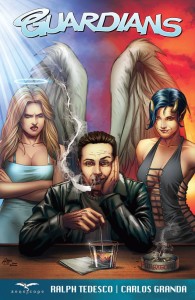 Over at the news site Comics for Sinners, you’ll find my review of
Over at the news site Comics for Sinners, you’ll find my review of 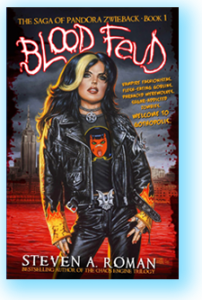

 Okay, actually it’s a
Okay, actually it’s a  It’s February, and that means it’s time again for
It’s February, and that means it’s time again for 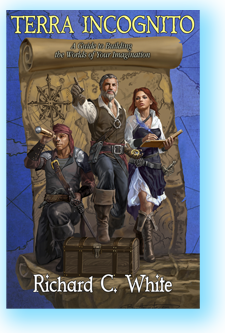 Hey, e-book lovers, you can now find the ePub edition of
Hey, e-book lovers, you can now find the ePub edition of  As some of you may be aware, since 2014 I’ve been a comic and graphic novel reviewer for the news site
As some of you may be aware, since 2014 I’ve been a comic and graphic novel reviewer for the news site 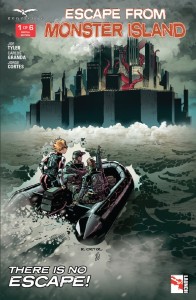 Over at the news site Comics for Sinners, you’ll find my review of
Over at the news site Comics for Sinners, you’ll find my review of 